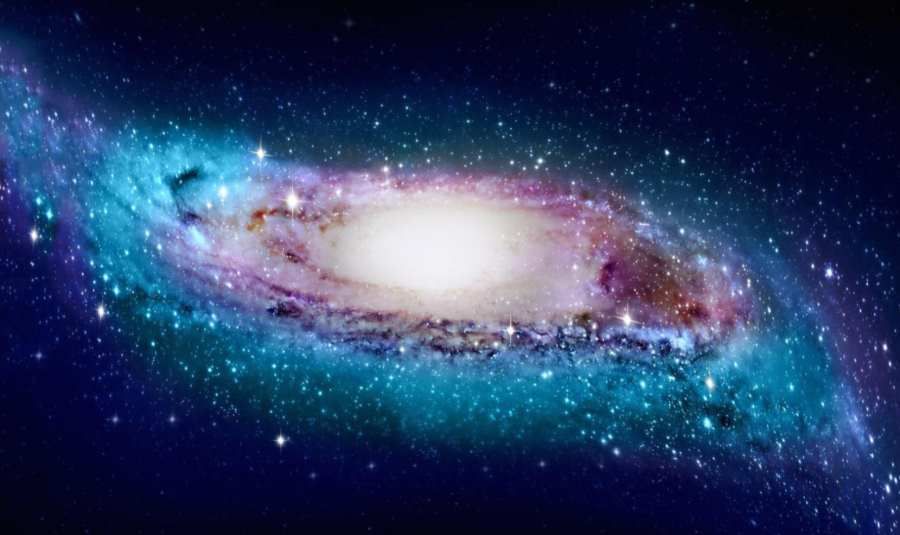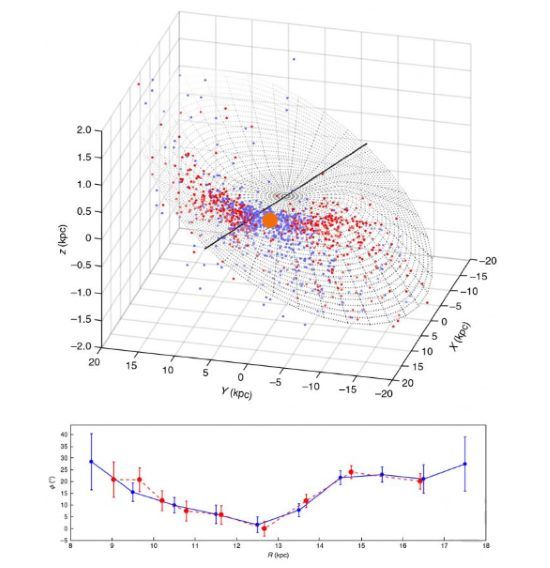
Milky Way curves at the edges
New research has shown that the shape of the Milky Way is far from an elegant disk shape. This disk is not stable or flat and the farther away from its center, the more distorted and twisted it becomes.
From a distance, our galaxy would look like a thin disk of stars, ktore once in several hundred millionoin years orbit the central region of the. This massive central area, along with hundreds of billionoin stars and with a huge amount of dark matter, provides gravitational „glue”, to hold it all together.
But the farther away from the galactic center, the gravitational pull weakens. In the Milky Way’s distant outer disk, the hydrogen atoms that make up most of the galaxy’s gaseous disk are no longer confined to a thin plane, but give the disk an S-like appearance.
Often a poreowe lump the Milky Way in with our neighbor, Andromeda. Andromeda is probably larger than our galaxy, but in fact both are quite large, both are spiral galaxies and both are of similar age.
Because we live in the Milky Way, we cannot actually observe its full shape. But given what we know about galaxies in the ogole, one can venture to say that the Milky Way probably looks a bit like Andromeda, with nice orderly spiral arms. However, this is not quite the case.
Astrophysicists from Macquarie University in Australia and the Chinese Academy of Sciences have discovered that the farther away from the galactic center, the Milky Way is more warped and twisted. Its plane is not a straight line. The results of a study confirming this have been published on „Nature Astronomy”.
To such conclusionsow scientistsow prompted new measurements of the distance to stars in the outer regions of the galaxy – The so-called. Cepheidsow. Classical cepheids are young stars thatore are four to 20 times larger than our Sun and up to 100,000. times brighter. Such large masses of these objectsoin suggest that these stars live quickly and die young – sometimes only at the age of a few millionoin years. Their distinctive feature is that they pulsate at a precise frequency, which is observed as changes in their brightness. This allows astronomers to calculate their size and reasonably accurate distances to these stars.
– It is difficult to determine the distance from the Sun to the Milky Way’s outer gas disk without having a clear idea of what the disk actually looks like – said Dr. Chen Xiaodian of the Chinese Academy of Sciences, head of theowny author of the publication. – We recently published a new catalog of well-known variable stars known as classical cepheids, for which theorych can be determined distances with an accuracy of 3 to 5 percent. – added.
This database allowed the team to develop the first, accurate, trojdimensional image of the Milky Way including distant outer regions.

Distribution of classical cepheids in the warped disk of the Milky Way. Photo. Chen Xiaodian
– To our surprise, we discovered that our trojdimensional collection of 1339 Cepheids and the Milky Way’s gas disk are very close to each other. This gives new insights into the formation process of our galaxy, explained Prof. Richard de Grijs of Macquarie University in Sydney, Australia, cooarticle author. – What’s more, we have discovered that in the outer regions of the Milky Way, the disk of stars resembling the letter S is warped in an increasingly twisted spiral pattern – added.
The researchers’ conclusions appear to confirm earlier observations of more than a dozen other galaxies, whichore roalso showed similarly twisted spiral patterns. – Combining our results with other observations, we concluded that the distorted spiral shape of the Milky Way is most likely caused by the rotational interaction of the massive inner disk of the galaxy, said Dr. Liu Chao, coohe author of the publication.
– The disk precession seems to suggest that the massive inner disk of the Milky Way mohead force the outer disk to follow its rotation, but the rotation of the outer disk lags behind – this causes torsion – explained de Grijs.
SourceoSource: Chinese Academy of Science, EurekAlert!, photo. Chen Xiaodian


